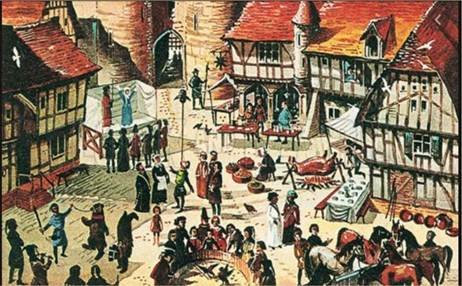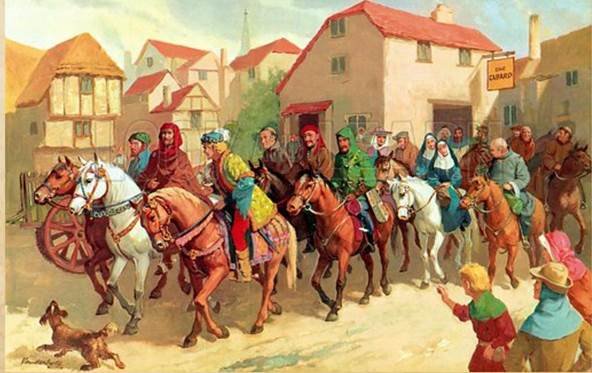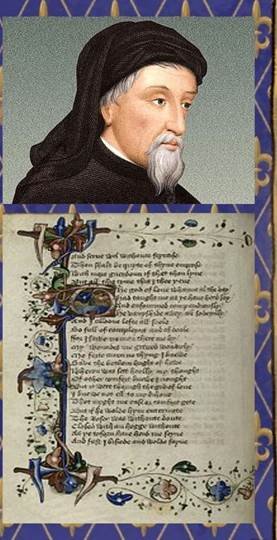Презентація: "The High Middle Ages. Part II"

![]()

![]()
 MEDIEVAL TOWNS
MEDIEVAL TOWNS


The people of the first towns were not free. All the land in feudal England was divided into manors and the lord of the manor governed the townspeople who lived on his land and made them perform feudal services.
 The merchants and craftsmen agreed to pay for the use of land in money instead of services. Bit by bit the townspeople gained other rights in exchange for money payments.
The merchants and craftsmen agreed to pay for the use of land in money instead of services. Bit by bit the townspeople gained other rights in exchange for money payments.
In return for the money paid, the king would grant the townspeople a Charter. This was a written agreement listing the things the townspeople could do without permission from the king.
In the 12th century many
English towns such as
London, Canterbury, Dover,
Lincoln, Nottingham, Norwich,
Oxford, Newcastle, Southampton, Bristol and others had charters and exercised self-government.
The king gave many privileges to the capital of the country. The Londoners took the local government over the city and the county; they appointed a sheriff and a judge and collected all the dues which formerly had been paid by the inhabitants of the county to the king. In return, every year the Londoners paid 300
pounds sterling to the king.
Gradually the towns' charters made it a rule that a serf who had run away from his lord could become free after having lived a year and a day in town. The landlord was forced to regard all runaway
serfs as free citizens of the town.
![]()
![]()
![]()
![]()
![]()
![]()
![]()
![]()
![]()
![]()
![]()
![]() Here is how the Charter of 1157 goes:
Here is how the Charter of 1157 goes:
. I confirm to the citizens
that if any remains in my city ofLincoln for a year and a
day without challenge from any claimant andpay the
customs of the city he shall remain peacefully in the city ofLincoln as my free man. "
Thus, in the 12th-13th centuries the townsmen of many English towns became free. They became free from the old feudal obligations and they themselves were responsible for the order and the government in the town.
Liberation from feudal power sped up the growth of towns and many of them became important centres of crafts and trade.
The town craftsmen produced goods only to order and for sale. The master-craftsmen of the same trade who lived in the same town united into societies which were called craft guilds [rw1bAV1fi].
MARKETS & FAIRS

People from the country would come to the town markets to sell their surplus produce and to buy the townsmen's goods. The town market was held, as a rule, on a certain day of the week.
On market-day stalls were put up in the market-place, which was in any open space near the center of the town.
Far more important and exciting than the weekly markets were the fairs. Fairs were held once a year and they lasted a week, or even two or three weeks.
The fairs as well as markets could also be held only with the king's permission and not every town had one. The same sort of preparations went on as for markets, but on much grander scale. Whole streets of stalls were put up, and the site was fenced round so that no trader could get in without paying toll on his goods.
At every fair there were all sorts of amusements: puppets and dancing dolls amused the children, clowns and jugglers sent the crowds into roars of laughter, acrobats and performing animals were always a great attraction.
DRAMA

in the High Middle Ages
Folk Plays,
Mystery Plays, Morality Plays,
Interludes
Drama as public entertainment in the Medieval period began from a religious ritual in the form of mystery plays, or miracle plays. The miracle play was encouraged by the Church in an attempt to bring to the illiterate the miraculous Bible stories: the Fall of Man, the Flood, and plays of the Nativity, the Crucifixion, the Harrowing of Hell and the Last Judgement. Eventually these amateurs moved from the cathedral to the village green and then to pageant wagons bringing early theatrical performances to the neighbouring settlements. The most durable of the surviving English mystery plays was Noah's Flood, which was still sometimes performed when Shakespeare was a boy.
The miracle play was followed by the morality play, in which actors represented virtues and vices, such as as Patience and Greed , and the central aspect was the conflict was between good and the evil. The most widespread morality play is Everyman, which tells how the hero, Everyman, finds out that his only devoted friend is Good Deeds. Performed by wondering players, the morality plays were predecessors of the professional theatre in the reign of the Queen Elizabeth Tudor.
The High Middle English Literature
POETRY
Middle English literature is carried by a variety of voices, addressing different social classes. The native language and culture went side by side with those of Anglo-Norman rulers; important works were written in French or Latin, which is still used internationally for theology, science and history. When written literature appeared again at the end of the 12th century, it became extraordinarily rich not only in language but also in subject matter, tone and style. Middle English enriched with French introduced the medieval, chivalry romance and fabliau. Chivalry was an ideal for all knights and involved bravery, generosity, honour, and respect to women. Indeed, knights ventured into Wales and Ireland, or set off on a life-time journey to the Holy Land in the Crusades to regain Jerusalem from the Muslims.
English, though forced out of ordinary literary compositions, became the language of the ruling classes by the 14th century, when in 1363, a parliamentary session opened in English, and in 1366 it was used in the law courts. It lost former inflections, changed phonetically and borrowed a lot of words from Latin and French. The second half of the 14th century was the time when Geoffrey Chaucer (1343—1400) showed that English, a rich and wonderful language, is suitable for great literature. In his poem The Canterbury Tales hhe presented dynamic human portraits and told diverse stories.
The introduction of the printing press in 1476 by William Caxton (1421—1491) brought to light Chaucer's Canterbury Tales and Malory's Morte d'Aåhur. Thanks to Chaucer, the East Midland dialect of London had become the language of poetry, but there was no standard for prose. Caxton himself, when writing prose, wrote as he spoke.



![]() THE CANTERBURY TALES by GEOFFREY CHAUCER
THE CANTERBURY TALES by GEOFFREY CHAUCER
συεΤαΙΙ erbllTV
MIDDLE ENGLISH PROSE

In the picture: Wycliffe giving the priests his translation of the Bible
Prose writing, though mostly religious in content, flourished in Britain in the High Middle Ages. The reformer John Wycliffe (1330—1384) angered by the abuses of the church, opposed its teachings. Besides writing antireligious treatises, he made the first translation of the Bible into English. Other writers of religious prose such as Richard Rolle (1300—1349), of Hampole, Yorkshire, wrote treatises on mystical devotions in Latin and English. At the end of the 14th century, many mystical writers described how they overcame the world's troubles by an inward unity with God.
The best of these writings are the anonymous Cloud of Unknowing (1380), The Scale of Perfection by Walter Hilton (died 1396), and The Revelation of Julian of Norwich (1342—1416).
The High Middle Ages (XI—XIV). Part 2
Questions for discussion:
1 . What is a town charter?
2. How can you explain the following medieval saying: "The town air makes ![]() free"?
free"?
3.  What privileges did the Londoners gain?
What privileges did the Londoners gain?
4. If you were a citizen living in a medieval town, how could you describe a market and a fair?
5. What sorts of amusements were performed during the medieval fairs?
6. Drama in the High Middle Ages.
7. Poetry in the High Middle Ages.
8. Prose in the High Middle Ages.


про публікацію авторської розробки
Додати розробку
